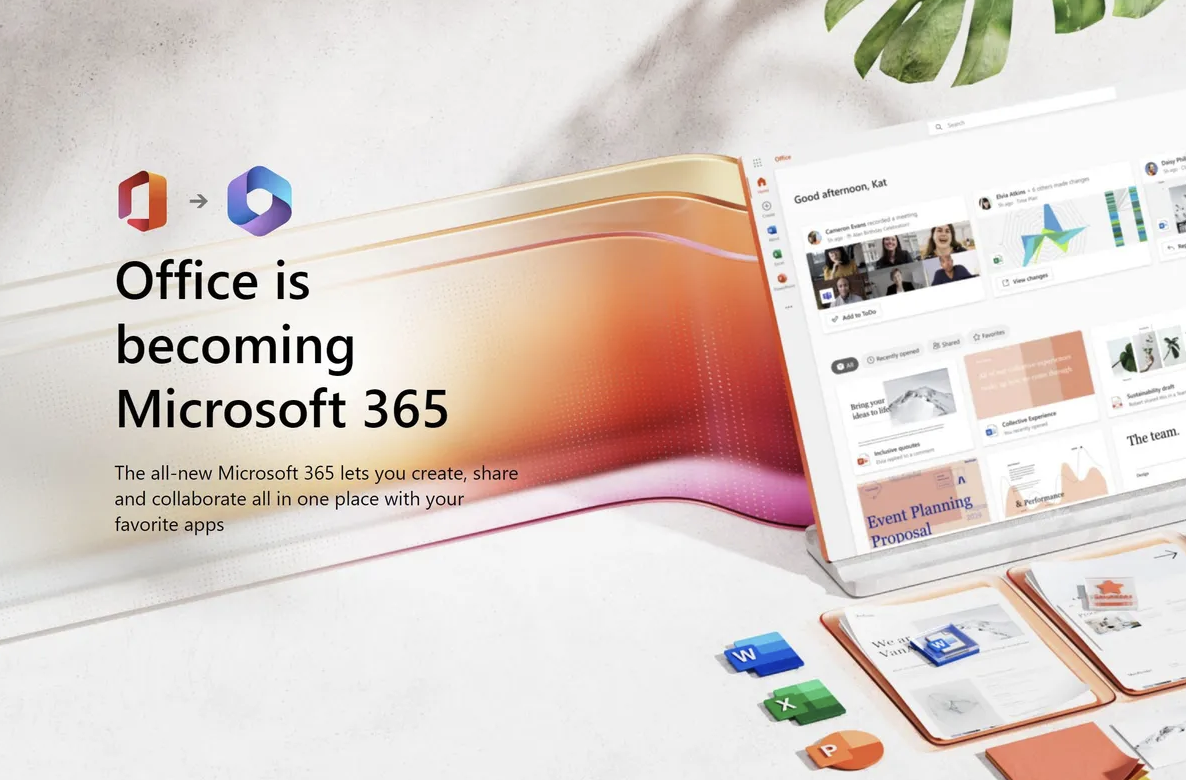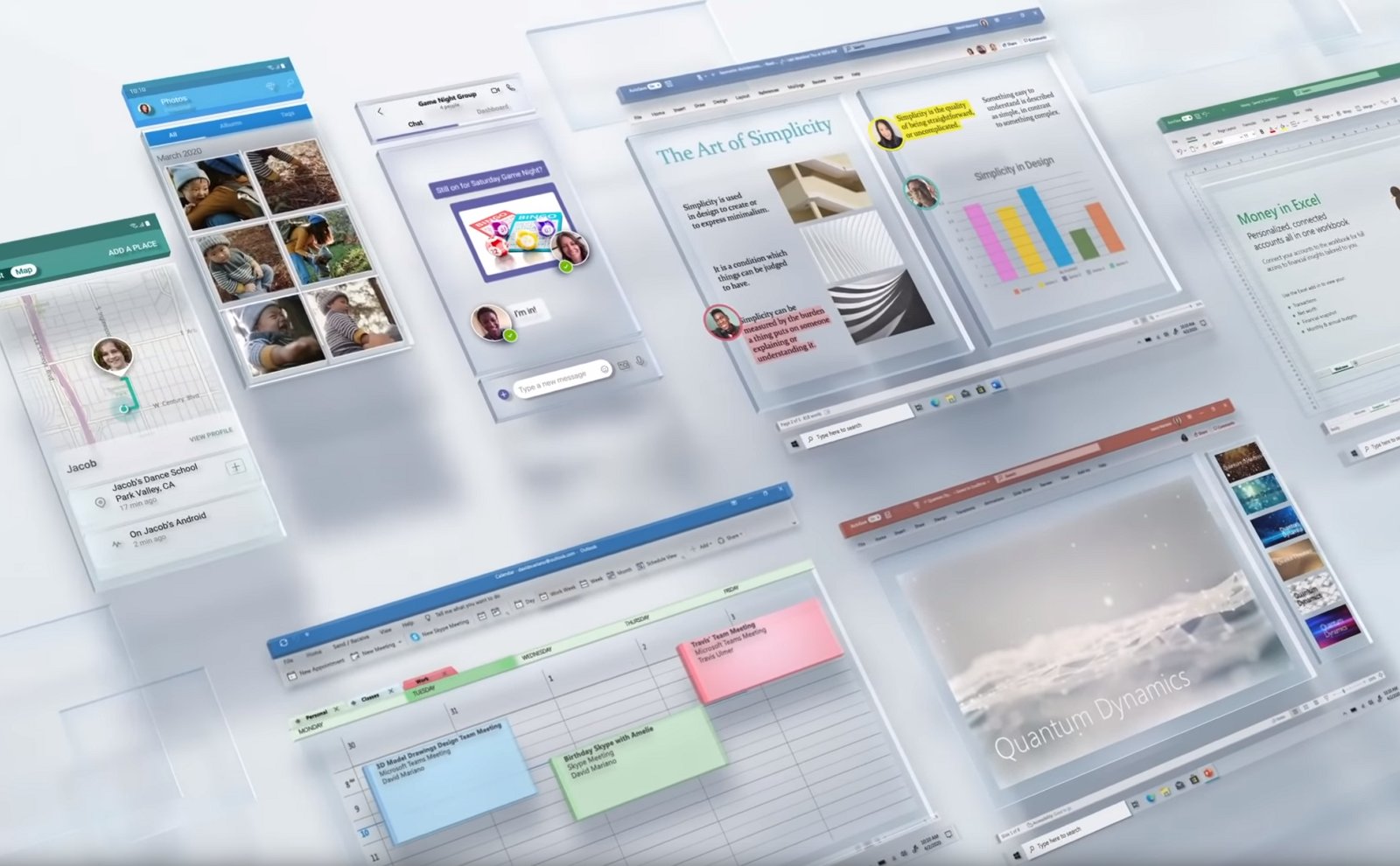Microsoft Office, which grew up with a generation, is becoming history.
In October of this year, Microsoft announced that it would carry out a “rebranding” of Office. The new brand was named Microsoft 365, which still includes office software such as Word, Excel, and PowerPoint, but the word Office will be swept into the old pile of paper.
Since its birth in the 1990s, Office has always been the most core and mainstream software in the office scene. It can be said that as long as you work with a computer, you cannot avoid it. For many people, the three major Office items even represent all the needs in the office. Later similar software, whether WPS or Google Docs, have adopted similar functional design.
In recent years, with the transformation of office software in the direction of SaaS (Software as a Service), Microsoft has also innovated Office. It no longer only sells software, but also began to sell services, and launched the Office 365 subscription service, making it a Get closer to the cloud.
“Office” is changing, and so is the way people work. The rise of “collaboration” office platforms such as Slack has changed the market landscape of office software.
Until the post-pandemic era, the pace of change has accelerated, and people are no longer limited to “offices” where they work, forcing Microsoft to make a little, more profound change.

Microsoft rebrands Office to Microsoft 365 | Microsoft
Universal productivity tool
For most people, especially after the 1990s, Office may be the first “productivity software” they used after they came into contact with computers, and it was also the only choice on the market at that time – it was even a subject of the national computer grading exam. .
But the birth of Office was not as dramatic as many tech giants, such as Apple and Facebook.
In the early 1980s, Microsoft ‘s first software was a spreadsheet software called Multiplan . Later, Microsoft developed Multi-Tool Word, both of which are the predecessors of Excel and Word . Word and Excel were not the only office software on the market back then. At that time, the market was small, but there were many competitors, including software from big companies such as IBM Works.
What really changed the game was Windows. With the advent of the Windows operating system, especially in the 1990s, with the success of Windows 3.0 and Windows 95, Microsoft established its dominance in the operating system field.
Office is also taking off.
In 1990, Microsoft first packaged Word 1.1, Excel 2.0, and PowerPoint 2.0 into the Office suite. After that, as Windows swept the world and rapidly became popular, Office quickly became the mainstream choice.
Although personal computers are consumer goods and users have the right to make decisions independently, they are still largely affected by the inertia of organizations and society. From the 1990s to the 1900s, generations of students learned Office in school, and after entering the workplace, companies used Office. This inertia has continued and has not completely subsided until today.
For Microsoft, this seems to be the best business model: relying on corporate purchases to generate solid cash flow and profits while building user habits.
It wasn’t until the late 2000s that the tide of the Web 2.0 revolution came, introducing new variables to the office software market and having a big impact on Office.
Office is software that revolves around office logic . For example, in Word, what the user operates is a “virtual paper”. Because in the office, you edit text on the computer, and the final destination is usually printing, so most of Word’s functions are to adjust the typesetting of text on “paper”.

WordPress makes it easy for users to quickly build websites and publish content|iTheme
But in the era of Web 2.0, the main publishing medium is no longer “paper”, but “web page” . When a user needs to publish text to a web page, he no longer needs those complicated typesetting functions, but only needs to simply mark the text and focus on the content itself. In the process, a “Web Publishing Standard” similar to Markdown was born.
Also, in the Web 2.0 era, the web pages themselves started to become interactive. Twitter and Facebook only use a simple text box to give users the ability to “write and publish text”. The birth of Google Docs is to move a “simplified” version of Office to the web. Users do not need to purchase or install software, just enter the web page and start editing text, processing tables, and making slideshows.
The era of SaaS begins.
More and more people are starting to use those web-based and cloud-based software. Because their needs are inherently light, the web side is obviously simpler and more flexible.
Today, Google’s online office suite, G Suite, has more than 2 billion users . And Google has already set its sights on classrooms and began to cultivate its own “next generation users.” With inexpensive Chromebooks, Google has put its own hardware into elementary and middle school classrooms. In 2017, Google’s hardware and software market share in the US primary and secondary education market has reached as high as 60%.
This means that the next generation of professionals will no longer grow up with Office.
Microsoft’s “B-side” pivot
The past decade has seen the rise of SaaS, and Office no longer has the dominance it once did, but Microsoft has never sat idly by.
Microsoft’s trump card is still on the “B side”. Taking the “B-end” as a fulcrum, Microsoft has successfully countered the rise of multiple rivals and maintained its kingship in the field of office software.
One of the most famous battles is the “blocking” of Slack.
In 2014, Slack was launched, focusing on the chat communication function in the office scene. The team has designed a unique information organization framework to increase communication efficiency, and the entire platform is very open, and various functions can be extended through third-party interfaces, such as tracking project progress and sharing files with network disks. Various product details are also polished very finely.
In just one year, Slack’s number of users has grown to 1.7 million, and it has grown into a unicorn in the field of office software.
Compared with all the office software in the past, the biggest feature of Slack is that it is a typical “C-side software”. There was no sales team in the early days. Software is the same.
This kind of communication is often “bottom-up” within the team. It is a small number of grassroots employees who start to use it first, find it easy to use, and pass it on to team leaders, bosses, and then to the entire company.
At that time, many people believed that this C-end model of “spontaneous use by employees and then promoted to the whole company” would defeat those B-end models of “selling to the boss by sales, and then pushing it to the employees”.
In 2015, Microsoft made a sky-high acquisition offer to Slack, which was three times higher than Slack’s valuation at the time, but was still rejected by the latter. According to rumors, Bill Gates personally objected to the acquisition at the time, believing that Microsoft needed to make a similar platform by itself and could not rely on acquisitions .
After a year of hard work, Microsoft created its own Slack.

Microsoft’s Teams fends off Slack and Zoom attacks | Microsoft
In 2016, Teams was launched. It has many similarities with Slack in core functions, but it is obviously a product that is closer to the B-side idea. Teams focuses on security and stability, and is bundled with Office.
Relying on a strong sales and service team, Microsoft launched a fierce sales offensive to those old Office customers, providing customized service solutions, and even helping customers bear the cost of platform migration at a loss. This migration cost can sometimes be in the millions of dollars.
But Microsoft finally did it. In 2019, when Slack was listed with 10 million daily active users, Microsoft announced in a high-profile manner that the daily active users of Teams had exceeded 13 million, giving Slack a head-scratching drink and announcing the “blocking war”. victory.
Afterwards, Slack protested to the European Commission, saying that Microsoft bundling Teams and Office was suspected of unfair competition, but it did not achieve any substantive results.
With the B-side as a fulcrum, Teams also thwarted another opponent, Zoom.
In the spring of 2020, the new crown epidemic began to spread in the United States, and various companies and schools took measures to work remotely and attend classes. Within a few weeks, Zoom, with its excellent product design, quickly occupied the top spot in the app store and became the choice of most C-end users.
In April, when Zoom was busy fixing a privacy bug, Microsoft mobilized 50 employees and began an offensive against teachers in the New York education system to help them quickly switch from Zoom to Microsoft Teams. At the same time, Microsoft’s engineering team worked closely with the technical support team to rapidly develop new functions for classroom scenarios such as “raise your hand to speak” in response to the needs of teachers, which has won the recognition of a large number of teachers.
In just a month, Microsoft dampened Zoom’s momentum, ensuring that Teams wouldn’t be out of the race.
In the past 30 years, Microsoft has proven its ability to do to B business time and time again. From Windows to Office to Azure cloud services, it is through the pivot point of the B side that Microsoft has become a leader in providing secure, stable and customizable services. One of the most evergreen companies in Silicon Valley.
By winning the “office”, Microsoft has achieved what it is today, but the “office” is not the future.
The era of no “office”
In the course of the development of Office, Microsoft has not made a “personal” attempt.
For example, Office 365 was originally a reform for individual users. From the buyout system to the subscription system, Microsoft lowered the price of the product, and users only need to pay a relatively small monthly fee and annual fee to use the full set of the latest Office products, as well as the cloud synchronization function across devices.
It’s just that individual users are far inferior to enterprises in terms of willingness to pay and stability, and cannot bring in huge income. A series of startups, including Slack and Zoom, basically follow the rule of “the closer you are to the C-end and the farther away from the B-end, the harder it is to make money.”

Concept map of Microsoft 365 software in Windows 11 | Microsoft
By grasping the B-end, you can grasp the current market and income; but only by grasping the C-end can you grasp the needs of future users and the direction of development.
Just a day before announcing the rebranding of Office, Microsoft attended the Meta Connect launch, announcing that the two companies would be collaborating in VR, bringing Office, Teams, and even Xbox cloud gaming to Meta’s Quest VR platform. .
“We’re bringing the Teams immersive meeting experience to the Meta Quest, giving users a new way to connect with each other. We’re also bringing Windows 365 to the Quest, so users can personalize in a whole new way. Windows experience,” Microsoft CEO Nadella said at the press conference.
Obviously, the Meta Quest is not a “productivity device” and the Metaverse is not some “office place”, but Microsoft still chooses them as its next destination.
Because for Microsoft, the question is not where the future office will be, but where the people will be.
Relying on Windows bundled sales, the era of software that can be sold by winning the company’s purchases is passing. When the boundaries between work and life are gradually blurred, Microsoft must focus more on building services themselves. In the past few years, Microsoft has spent a lot of time optimizing the experience of the Office suite on the Mac and iPad to achieve this goal.
Of course, for most users, change won’t come that fast. For a long time in the future, we will still use Word, Excel, and PPT.
During his keynote speech, Nadella explained the long-term goals of the new brand Microsoft 365: “Providing a complete, cloud-first experience that helps users save time, save costs, reduce complexity, and provide more innovative, flexible Sex and flexibility.”
Simply put, Microsoft wants to liberate services from the operating systems and software of the past and turn them into a fluid and more flexible thing.
This is also the meaning of abandoning the old brand of Office: everything in the future is no longer limited to the office.
This article is reproduced from: https://www.geekpark.net/news/310418
This site is for inclusion only, and the copyright belongs to the original author.